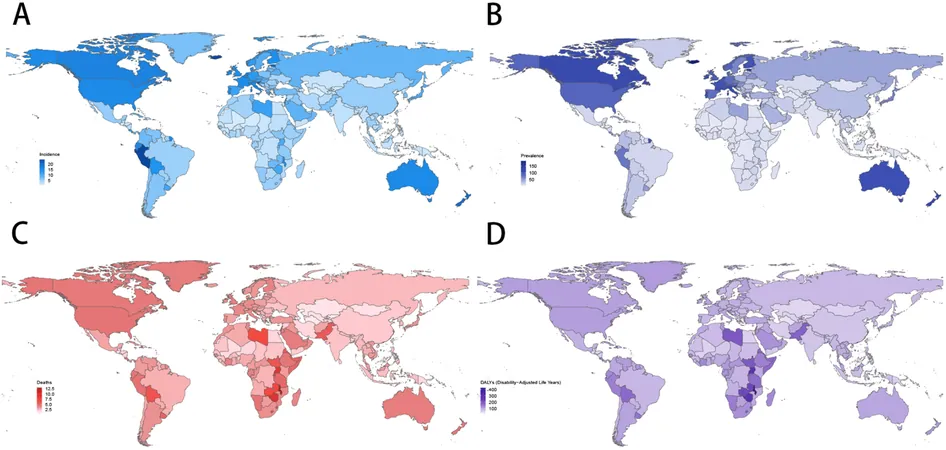
The Rising Tide of Non-Hodgkin Lymphoma: Trends, Projections, and Global Burden Analysis (1990-2040)
2025-03-31
Author: Li
Introduction
Non-Hodgkin lymphoma (NHL) is increasingly becoming a notable threat to global public health, exhibiting significant trends in incidence, mortality, and burden over the past three decades. The insights gathered from the 2021 Global Burden of Disease (GBD) dataset reveal alarming projections for the future, prompting urgent calls for enhanced disease control and preventive strategies.
Key Findings from the GBD Data
According to the extensive analysis of the GBD dataset, the world witnessed a staggering rise in NHL cases, from 255,667 new cases in 1990 to 604,554 in 2021. Notably, the age-standardized incidence rate (ASIR) doubled from 3.1 to 7.1 cases per 100,000 people over the same period. The most dramatic increases in NHL incidence were reported in Andean Latin America, which saw an annual percentage change of 3.3.
During this period, global prevalence surged to 2,919,051 cases by 2021, correlating with an age-standardized prevalence rate (ASPR) of 34.3 per 100,000—a significant increase from 22.3 in 1990. While the mortality rate associated with NHL saw a slight decrease—from 3.6 deaths per 100,000 people in 1990 to 3.2 in 2021—the number of deaths rose to 267,061, indicating a complex interplay of factors influencing patient outcomes.
Understanding NHL Burden through Socio-Demographic Indices
The analysis elucidated a stark relationship between socio-demographic factors and the burden of NHL. For instance, countries with high socio-demographic indices (SDI) demonstrated significantly higher ASIRs compared to lower SDI regions. This disparity underlines the multifaceted nature of NHL, intertwined with factors such as access to healthcare, diagnostic advancements, and lifestyle changes.
Countries with higher income and better healthcare access exhibited a trend toward improved survival rates, while lower SDI areas faced grave challenges due to poor healthcare infrastructure and delays in diagnosis.
Risk Factors Contributing to NHL
A critical takeaway from the analysis is the identification of high body mass index (BMI) as a predominant risk factor for NHL. With obesity rates climbing globally, this paper highlights the increasing association between high BMI and lymphoma incidence, particularly in higher SDI regions. Additionally, lifestyle changes tied to urbanization—including sedentary habits and dietary shifts—are likely contributing to rising NHL rates.
Environmental factors, such as exposure to certain chemicals and infections like Epstein-Barr virus (EBV), exacerbate the risk profile for NHL in various demographics, further complicating the situation.
Future Projections: A Worrying Outlook
Looking ahead, projections up to 2040 indicate a continued increase in NHL incidence and prevalence. The ASIR is expected to stabilize around 8.4 cases per 100,000, while the number of new cases will likely rise due to population growth. Strikingly, although mortality rates are projected to decline gradually, the continued rise in cases will impose an enduring burden on healthcare systems, especially in low- and middle-income countries.
Gender Disparities and Age Trends
The prevalence of NHL continues to demonstrate notable gender disparities, with men facing a more than two-fold higher risk of diagnosis compared to women. Additionally, age-related analysis unveils a worrying trend: as age increases, so does the NHL burden. The highest rates of incidence, prevalence, and mortality were observed within the 60-80 age bracket, signaling a need for targeted screening and preventive strategies among older populations.
Conclusion: A Call to Action
The GBD data unveils a crisis in NHL that demands immediate attention. With rising incidence rates and demographic shifts, a collective response is necessary to implement effective screening programs, enhance treatment accessibility, and improve overall survival rates.
Healthcare policymakers and researchers are urged to prioritize NHL in their strategy planning, given its multifactorial nature and socioeconomic implications. As we advance towards 2040, a deeper understanding and commitment to tackling the burden of Non-Hodgkin lymphoma will be essential to shift the current trends and ultimately, spare millions from the grips of this insidious disease.
In essence, while there are potential rays of hope in improved mortality rates, the critical rise in incidence underscores an urgent need for global health interventions that tackle both lifestyle factors and systemic inequalities to effectively curb the rising tide of NHL.



 Brasil (PT)
Brasil (PT)
 Canada (EN)
Canada (EN)
 Chile (ES)
Chile (ES)
 Česko (CS)
Česko (CS)
 대한민국 (KO)
대한민국 (KO)
 España (ES)
España (ES)
 France (FR)
France (FR)
 Hong Kong (EN)
Hong Kong (EN)
 Italia (IT)
Italia (IT)
 日本 (JA)
日本 (JA)
 Magyarország (HU)
Magyarország (HU)
 Norge (NO)
Norge (NO)
 Polska (PL)
Polska (PL)
 Schweiz (DE)
Schweiz (DE)
 Singapore (EN)
Singapore (EN)
 Sverige (SV)
Sverige (SV)
 Suomi (FI)
Suomi (FI)
 Türkiye (TR)
Türkiye (TR)
 الإمارات العربية المتحدة (AR)
الإمارات العربية المتحدة (AR)